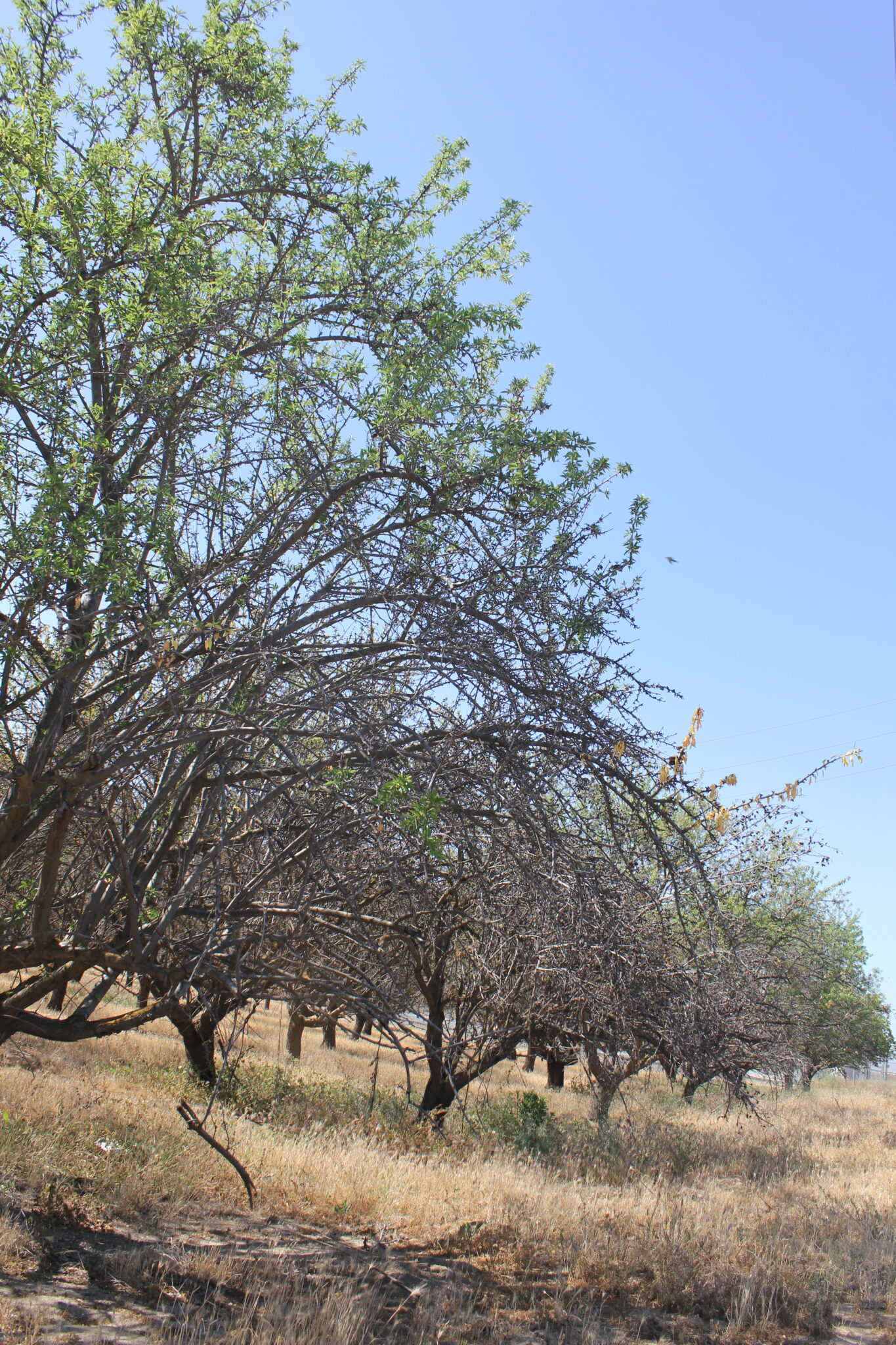
In a dry year, all water resources for tree nut crops, including stored soil moisture, rainfall, groundwater and surface water, must be managed efficiently to prevent significant yield loss and ensure tree survival.
A smaller-than-normal Sierra snowpack, depleted reservoir storage and below-normal rainfall going into the summer have caused concerns about adequate irrigation this year for permanent crops.
An almond drought management update from David Doll, The Almond Doctor, reported that while almond trees are relatively tolerant to drought, yields could take a hit when water is reduced. Not just the current year crop, but next year’s crop if the fruiting spurs do not develop due to water stress.
Doll explained that water stress affects the amount of energy a tree will use to develop kernels. Nut set may not be affected this year, but at harvest, size and weight of kernels can be reduced. Shriveled kernels reduce crop quality.
Deep-rooted pistachio trees are more drought-tolerant than almond trees, but their production can be adversely affected if water stressed during certain stages of nut development. The percentage of split nuts and nut weight are most sensitive to water stress during the growing season.
Walnut growers have benefitted from UC research that shows irrigation delays in the spring may help them improve crop quality and tree health as well as save water. Up until mid-June, when nuts have reached full external size, orchard water use is low compared to summer water use.
In almond production, Doll said that for every percent total water is reduced, the crop loss expected that year would be the same percentage. Doll stressed that this relationship is not exactly defined and that the numbers are estimates.
It is the next year’s crop that can suffer from moderate to severe water deficits. The crop loss is due to reduced spur positions from the lack of growth and reduced carbohydrate reserves going into floral bud development. This will lead to reduced nut set next year, Doll said. Nut weight and size of that crop will not be affected unless reduced irrigation continues that season.
Water stress from the previous year can approach a 1:2 ratio the next year. For every percent of reduced water during the first year, the crop loss can be reduced by about 2% the following year, even if that second crop receives normal irrigation amounts. Doll said two years of full irrigation are needed to bring an orchard back to yielding its production potential.
Irrigation Strategies in Almonds
Soil type and stored soil moisture play a part in initiation of irrigation.
High water holding capacity will allow for delay of irrigation in the spring. Sandy, shallow soils have less capacity to hold water. Late spring rains may also help delay irrigation.
A late April rainstorm had only minimal impact on replenishing soil moisture. Doll noted that it takes at least a half-inch of rain to refill soil moisture levels.
An update of the UC Drought Management for California for almonds states that taking into account pressure chamber readings, soil moisture levels and in-season rainfall, the first irrigation for almonds may be delayed as late as early May. It is currently advised to begin when trees reach two bars more negative than baseline, which, in the spring, ranges from negative six to negative eight bars. Delaying the start timing until this point is reached can reduce spring water applications by several inches.
UC research has shown that if the deeper root zone has some level of moisture drawdown prior to the first irrigation, there are root health benefits and potential for a more stress-resilient tree.
Proportional deficit irrigation is the preferred strategy in almonds. UC Drought Management states that if only 30% of the irrigation water is available, the orchard should be irrigated at 30% of the crop’s evapotranspiration for the entire season.
Crop Advisor Bill Brush said timing of deficit irrigation is critical to kernel quality.
“If you cut back on water too early, there will be some kernel shrivel,” he said. “Once you start to cut back on water, the necessary nutrients won’t be taken up by the tree.”
Brush said that conditioning the trees to use less water should be done over time. By the end of May, nut development is at a stage where less applied water won’t affect quality or kernel size. By the end of July, depending on harvest date for the variety, the trees could go with only one or no August irrigation.
Pistachios and Drought
Pistachio trees, Brush said, have a few traits that make them less vulnerable to drought conditions. Their canopies tend to be thinner than almonds or walnuts and the trees lose less water to transpiration. The root system doesn’t actively mine for water or nutrients, making it more tolerant to water stress.
Pistachio trees do need water later in the growing season as the nuts mature at the end of the cycle. Water drives kernel expansion, which splits the shells.
The UC Pistachio Production manual reports that mature pistachio trees can use 30 to 50 inches of water over the growing season depending on soil moisture reserves. The trees are most tolerant of water stress from mid-May through early July and postharvest. Trees can yield their full potential with 80% to 85% of full-season evapotranspiration.
Successful deficit irrigation programs do require full winter recharge of the soil profile and understanding of soil water holding capacity and salinity.
A UC publication on managing pistachios in drought conditions reports there are two ways to schedule irrigations: apply water to meet estimated demand or apply irrigation to replace water used that week. The first uses historical evapotranspiration (ET) for the specific area. It can result in deficit irrigation if the crop is more vigorous or temperatures are warmer than expected. The second method uses real time CIMIS ET and crop coefficients to calculate real water use. Water use estimates are made from using sensors or a hand probe.
Meeting Walnut Tree Needs
Mature walnut orchards in the Central Valley can use 41 to 44 inches of applied water per acre over the growing season. Like other tree nut crops, there are periods of nut development when adequate water is needed for size and crop quality.
UC Drought Management for walnuts states that excessive water stress can decrease nut size and quality.
Walnut kernel weights begin to increase in late June and filling continues into September. From mid-June through mid-August, water demand by walnut trees reaches a peak for the year. Based on ET, water use in inches goes from 3.98 to 4.16 for fully irrigated walnuts in the northern Sacramento Valley. During hull split, sufficient water is needed to prevent hull tights and darkening kernel color. A second root flush occurs in September and October and controlled levels of deficit irrigation can help harden off new shoots and prevent freeze damage. UC research on deficit irrigation in walnuts showed that withholding water during late-season tree and nut growth stages may save the most water with the least negative impact on tree health and productivity. Mid-season kernel fell and nut development can also be a time to save water, but yield will be reduced and some crop quality loss can be expected.















